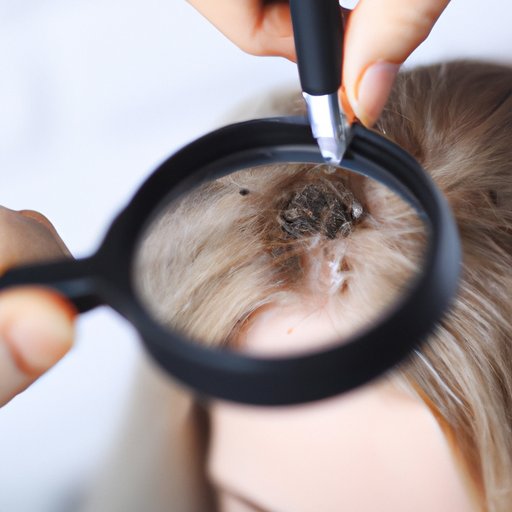
Introduction
Head lice infestations are a common problem that affect people of all ages. They are highly contagious and can be a nuisance to deal with. Despite the prevalence of head lice, there are many myths and misconceptions surrounding these pesky critters. One of the most common beliefs is that having just one louse on your head is not a problem. However, is this really true? In this article, we will explore the possibility of having just one louse on your head and the truth behind this myth.
Exploring the Possibility of Having Just One Louse on Your Head
Head lice are tiny insects that live on the scalp and feed on blood. They are spread through close personal contact, such as sharing combs, brushes, hats, and other personal items. The most common symptom of head lice is itching, which is caused by the saliva of the louse. However, not everyone experiences itching, and some people may be asymptomatic.
There is a common belief that having just one louse on your head is not a problem and does not require treatment. This belief is based on the assumption that a single louse cannot reproduce, and therefore cannot lead to a full-blown infestation. However, this is a myth.
The Myth of the Solo Louse: A Scientific Investigation
Studies have shown that even one louse can indicate a larger problem. One female louse can lay up to six eggs a day, and these eggs can hatch in as little as a week. This means that a single louse can quickly lead to a full-blown infestation if left untreated.
In addition, head lice have been found to be more prevalent than previously thought. According to the Centers for Disease Control and Prevention (CDC), an estimated 6-12 million infestations occur each year in the United States alone, mostly among children aged 3-11 years.
What to Do When You Spot a Lone Louse
If you spot a single louse on your head, it’s important to take action immediately to prevent a full-blown infestation. The first step is to confirm that it is indeed a louse and not another type of insect or debris. You can use a lice comb to carefully comb through the hair and look for live lice or nits (lice eggs) that are firmly attached to the hair shaft.
If you do find live lice or nits, there are several treatment options available, such as over-the-counter shampoos and prescription medications. It’s important to follow the instructions carefully and to repeat the treatment as necessary to ensure that all lice and nits are eliminated.
In addition to treatment, it’s important to take steps to prevent the spread of lice. This includes avoiding close personal contact with others, washing bedding and clothing in hot water and drying on high heat, and vacuuming carpets, furniture, and car seats.
Understanding Louse Infestations and the Probability of Having Only One
Head lice infestations are often associated with poor hygiene, but this is a misconception. Lice infestations can happen to anyone, regardless of their cleanliness or socioeconomic status. They are most commonly spread through close personal contact, but can also be spread through shared personal items.
While it is possible to have just one louse on your head, it is unlikely. Lice are social insects that thrive in groups, and it is rare for only one louse to be present. Finding a single louse is a warning sign that there may be more lurking nearby.
Don’t Be Fooled by a Single Louse: The Truth About Head Lice
There are many misconceptions about head lice, which can lead to a delayed or incomplete treatment. One common myth is that lice can fly or jump, but in reality, they can only crawl. Another myth is that lice prefer long hair, but they can infest both short and long hair.
It’s important to take head lice infestations seriously, as they can lead to complications such as bacterial infections and skin irritation. In addition, they can be a source of embarrassment and social stigma.
The Importance of Proper Lice Detection and Treatment, Even with Just One Louse
Even if you only find one louse on your head, it’s important to take action immediately to prevent a full-blown infestation. Prompt and thorough treatment can help ensure that the lice are eliminated and prevent the spread to others.
Effective detection and treatment require patience and attention to detail. It’s important to carefully comb through the hair and follow the instructions for any treatment products. In addition, it’s important to take steps to prevent future infestations, such as avoiding head-to-head contact and not sharing personal items.
Conclusion
In conclusion, having just one louse on your head is not a myth, but it is unlikely. It is important to take any signs of lice infestation seriously and to take prompt and thorough action to prevent a full-blown infestation. By understanding the prevalence and symptoms of head lice, and taking steps to prevent and treat infestations, we can help keep ourselves and others healthy and lice-free.





